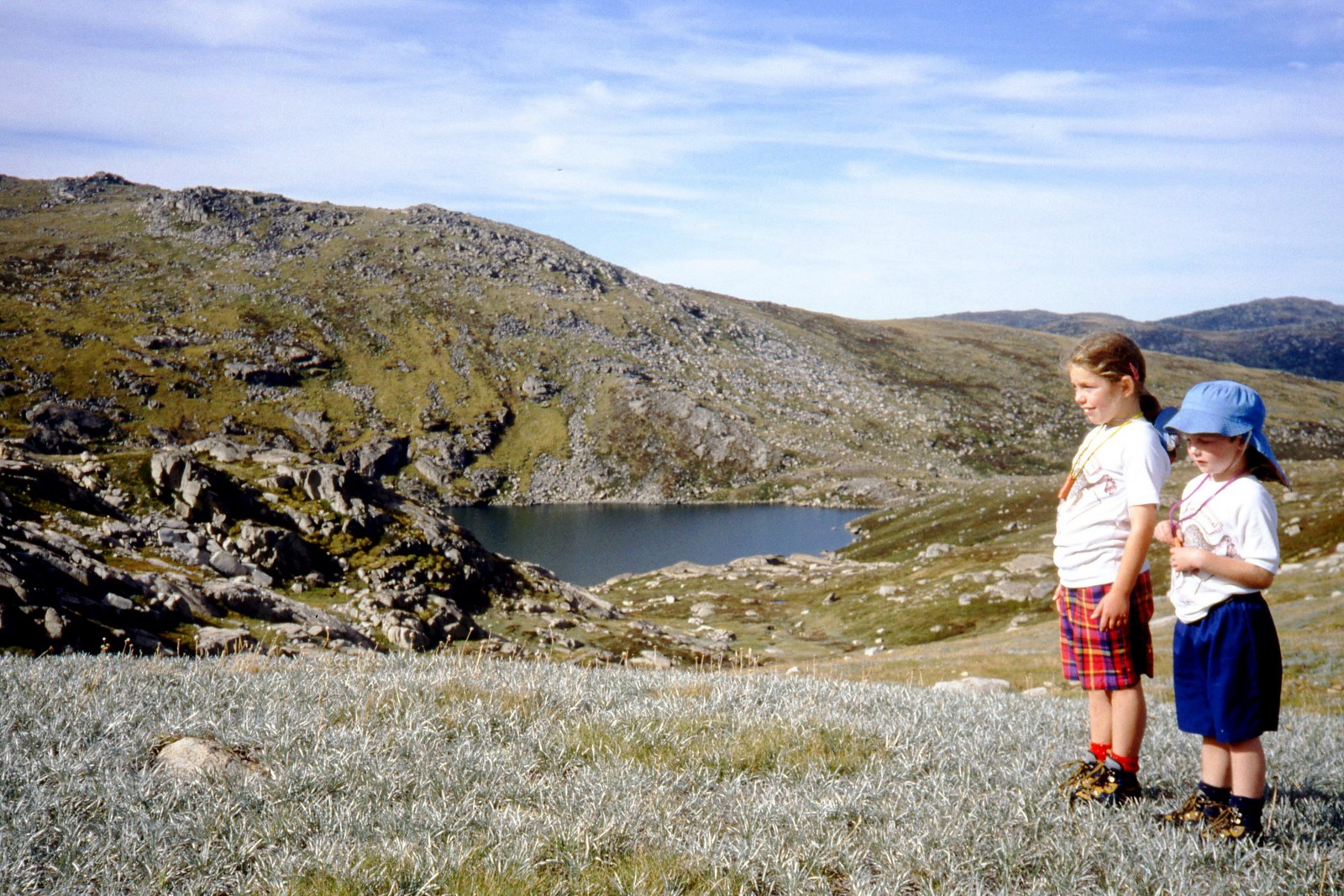Reading Time: 11 minutes
Bushwalking is a thoroughly enjoyable and rewarding activity to experience as a family, an extended family or with several families. It is particularly special to introduce children to the natural environment and the joys of walking in the Australian bush.
For many parents, their memories of bushwalking as children are a strong incentive to go walking as a family.
For children, bushwalking helps develop valuable skills and knowledge including:
- Self reliance, confidence, cooperation and persistence
- Importance of exercise and fresh air
- Importance of planning and preparation
- Natural history; Australia’s unique flora and fauna
- Map reading and navigation
- Safety in the bush
Safety
Taking children along on a bushwalk adds a significant layer to the safety considerations required when planning, preparing and undertaking the walk.
An understanding of these considerations is crucial and only comes with experience. For parents who are not experienced bushwalkers, it is important to proceed very carefully, by:
- Walking with friends who are experienced bushwalkers.
- Undertaking easy walks, e.g. nature trails in National Parks, that are well documented and signposted, with support and a safe retreat readily available.
- Joining a bushwalking club that offers family trips. Bushwalking clubs that have children on their trips need to follow the state’s child protection legislation.
General principles for walking with children

- Plan the walk carefully, including easier route options. It is important to strike the right level of adventure and challenge. Too much of either or both and a child’s enthusiasm for the next walk may be gone.
- Parents require suitable gear of their own, including sturdy footwear, clothing suitable for the weather conditions, map and compass, track notes, emergency communications device (a mobile phone may be adequate).
- Childrens’ gear should include:
- Footwear: correctly fitting boots or shoes, durable, with good tread
- Sun hat, beanie, gloves
- Waterproof coat
- Clothing: in layers, comfortable, no cotton
- Spare clothes. Children will get wet and muddy
- Own water bottle
- Favourite snacks
- Whistle, on a lanyard.
- Weather: Check the forecast. Do not proceed if the weather looks doubtful. Watch the weather while on the trip. Be prepared to retreat to shelter if the weather turns nasty.
- Supervise: Young children must be closely supervised. It cannot be assumed that instructions are remembered or fully understood. Particular hazards include: a dam, creek or river, a steep drop or cliff, biting insects, native animals, roads and vehicles, wandering off or running ahead.
- Protect from sun and insects. Use sunscreen and repellent.
- Feet: check regularly to ensure no sign of blisters and treat early.
- Clothing: Monitor carefully to ensure clothing suits the conditions. Children get cold much more easily than adults, especially when being carried in a backpack.
- Food: Favourites snacks and special treats are even more special in the bush.
- Hydrate: Ensure adequate water is drunk, especially in warm conditions.
- Highlights: Treat each highlight as a destination and stop to allow play time.
- Review each walk and make adjustments for next time. Length and difficulty of the walk, gear carried, footwear, what has been grown out of or lost, what was forgotten?
These notes are general advice only. Every child is different, every family is different and parents will have their own approaches to parenting. What is an easy walk for one family may be of no interest to or beyond the capabilities of another.
Babies (0-6 months)
Walks with a baby are limited by their tender age.
- Either a pusher or a baby sling worn on the front is required.
- Some pushers are of more robust “all terrain” construction with larger wheels and storage, very suitable for longer walks on rougher and unsealed tracks. Check models and seek advice before purchase.
- The “gear list” includes: water, formula, favourite toys, additional clothes, spare nappies, sealable plastic bags, wipes, small groundsheet and blanket, rain and sun protection.
- Backpack baby carriers are not suitable for young babies as they do not support the baby’s head.
Where to walk?
Linear parks and larger parkland areas in the suburbs and towns are good places to find longer walks. Many national parks and state parks have ‘nature’ walks that are well documented with track notes and mud maps. Many of these walks are suitable for pushers (wheelchairs). Check before starting.
Infants (6–12 months)
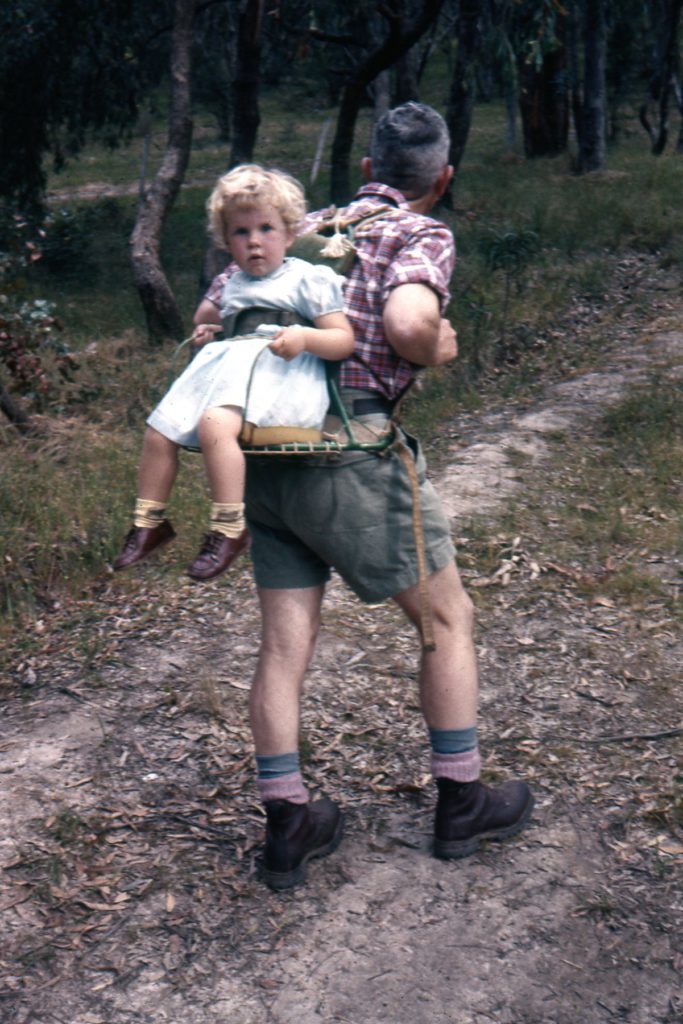
Child carrier circa 1960 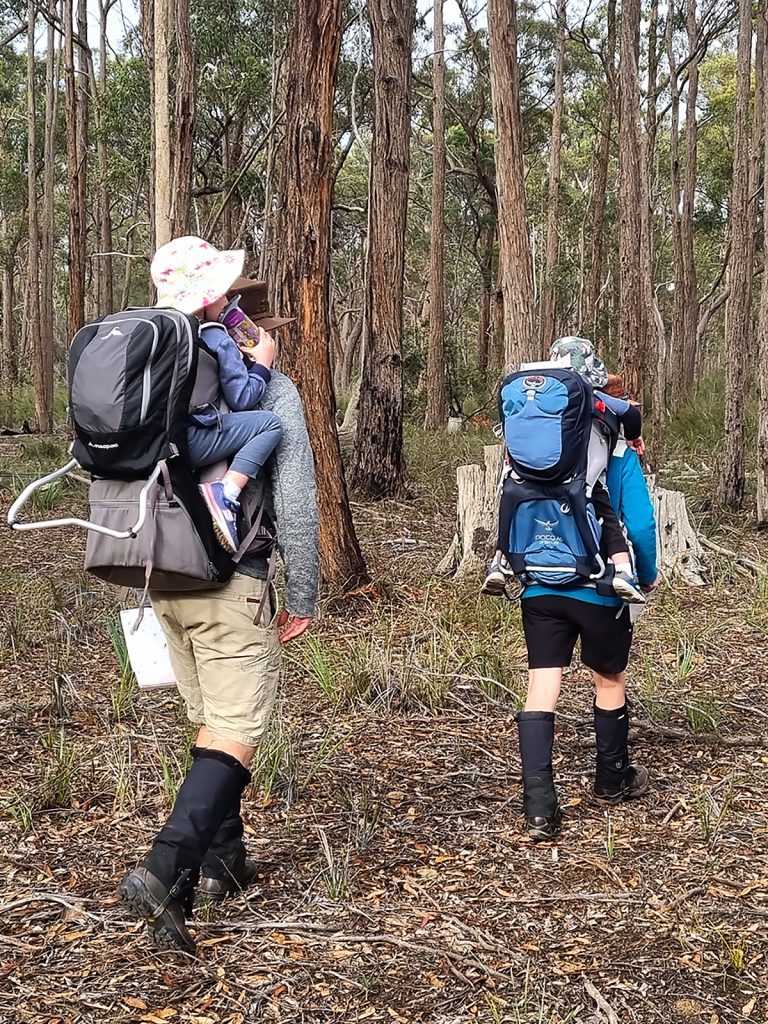
Modern versions
At about 6 months, a backpack carrier becomes an option, as the child can hold their head up and look around.
Get the right backpack child carrier
Check the available models carefully, as there is a considerable variation in design and features. Get advice to ensure that it suits the age of the child. A degree of head support is still important, as the infant will sleep in the backpack. Some additional storage is very handy.
Hints for walking with an infant in a backpack carrier:
- Plan walks to fit in with the child’s current sleep cycle, although they will most likely go to sleep anyway.
- The person carrying the backpack needs to be sure footed to minimise the chances of a fall. Walking poles are of great assistance.
- A child can easily get cold, wet, hot or sunburnt in a backpack carrier.
- Two adults are recommended for longer walks.
- One person should walk behind. They can monitor the child and be alert for the inevitable glitches: sun hat dislodged, biting insects, discomfort or distress, items being discarded. The loss of a hat, favourite toy, water bottle or shoe can see the walk end in tears.
- Off-track walking should be undertaken with great care, due to rough ground and the risk of scrub catching the child.
- All the usual items are still required: water, formula, snacks, favourite toy, additional clothes, spare nappies, wipes, sealable plastic bags, small groundsheet and blanket, rain and sun protection.
Toddlers and young children (1–4 years)
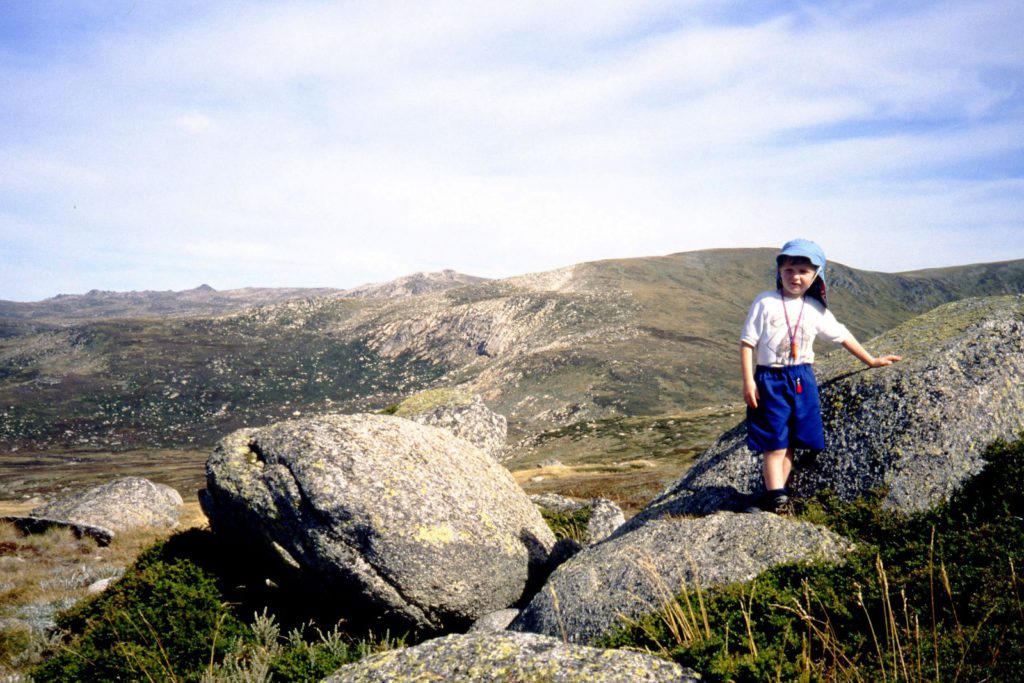
When a child can walk with confidence, the use of the backpack carrier can be gradually reduced. By four years old a backpack carrier should no longer be required. A four year old is rather heavy, anyway!
Walks near home in local parks are an effective introduction, and for training and rehearsal. This is the opportunity to check footwear, clothing and the other gear required for longer walks, and for parents to adjust to the slow pace of a walk with a young child.
The basics, such as the whistle on a lanyard, wearing a hat and having a drink from the favourite water bottle can be established.
A toddler can walk for the more interesting sections and be carried in the backpack when tired.
Highlights on the walk
Highlights are the essential ingredient; those planned and unplanned stops at interesting and adventurous places where there is a chance to explore and play. For example:
- A creek, where leaf boats can be launched or stones skipped. Water inevitably results in wet and muddy clothes, so spare clothes should be carried.
- A native animal is spotted; a parrot, lizard or a wallaby. Watching quietly can be taught.
- A log, tree or boulder to climb on.
- A bridge or a lookout.
Tips
- Walking with other families may be encouraging for the child, but it can result in the child being “dragged along”, expected to keep up with the larger group, other adults or older children, and less able to influence events and ask mum or dad to stop for a rest.
- Don’t push too hard. A toddler has limited energy and can easily ‘hit the wall’. It is far better to finish early than to push on and end up with a distressed child and perhaps frustrated parents, all reluctant to try that again.
- Special treats are useful to boost spirits. A chocolate frog mysteriously sitting on a log or rock can work wonders.
- After each trip, reflect on what went well, adjust expectations for next time and rectify any food and clothing issues.
Safety, supervision and hazards
Young children must be supervised closely all the time. Think backyard swimming pools. Toddlers and young children are especially at risk in an exciting but unfamiliar location and environment. Active supervision can be done in a way that does not diminish the child’s sense of adventure and the excitement of exploring a new environment.
Particular hazards:
- Cliffs or steep drops.
- Water; any lake, dam, swamp, creek or river.
- Biting insects: ants, march flies, mosquitoes, ticks, leeches.
- Stinging creatures on the beach, e.g. jellyfish.
- Native animals. They may have lost their fear of humans and be aggressive.
- Vehicles on roads, tracks or in car parks.
- The child wandering off or running ahead and getting lost.
Primary age children (5–12 years)

Now children can walk all the way and the backpack carrier is retired. An occasional piggy-back may help if really tired.
Correctly fitting and supportive footwear with adequate tread is crucial. Little feet grow fast, so check footwear regularly.
Involve the family in planning and preparation
Children can be involved, be introduced to some basic skills, and begin to take responsibility for getting ready and looking after themselves.
- Discuss the walk. Describe the route and highlights, aided by track notes and the map. Provide choice if available; “Walk around the lake or climb the hill to a cave?”
- Discuss the drive. A good map book, a hand drawn mud map or a tablet in the back seat, encourages the child to learn to answer “Are we there yet?” for themselves.
- Carry own gear. A small pack or bum bag can be used for some essentials; sun hat and warm hat, gloves, water bottle, nibbles and treats. Over time, encourage the child to be responsible for packing it. However, always check before the pack goes into the car and before starting the walk. The lollies might have been eaten, the water bottle emptied and the sun hat forgotten.
- Older children can use a small day pack and carry all their food and clothing for the walk.
- A whistle on a lanyard. Wearing it should become a habit.
- Lost procedure: “Stop. Find a sheltered spot nearby. Blow the whistle 3 times every few minutes.” This should be taught and reiterated regularly.
- Spare essentials. Take a spare sun hat, drink bottle and whistle as these can be lost.
On the walk
- Have objectives, e.g. the lookout then the lake then the cave.
- Set a modest pace. The pace must be that of the slowest group member; especially true when walking with children. Older children or other adults pushing on will turn a walk into an epic for a younger child.
- Stop at highlights:
- Some will be impromptu: a wildflower, water bird or lizard. Learn their names. A field guide is a handy reference.
- Some spots will be good for a play; paddle in a creek or a lake, look into a hollow log, climb a tree or boulder or collect the largest gum leaf.
- Have regular rests, and extra rests at places such as the top of a climb or the end of a beach.
- Ensure adequate water and snacks are consumed. Monitor this closely.
- Resolve problems early. Be alert for any issues, e.g. blisters.
- Review the route ahead. Point out features and relate to the map, the track notes or the guide book.
- Let children lead. Setting the pace and seeing new sights first is exciting, and a responsibility, but NEVER allow children to race ahead.
Active supervision remains important.
It cannot be assumed that a child will follow instructions or ‘rules’. “Stay away from the creek” can be a reminder that there is a really fun creek down there, and “don’t feed the animals” can be a prompt to “accidentally” drop a biscuit.
Review the trip
Check and reflect after each trip what went well, adjust expectations for next time, rectify any food and clothing issues.
Camping with young children
Camping adds another dimension to adventures in the outdoors. It is great fun for children, provided they are kept comfortable.
Australia has numerous delightful national park camping grounds, with toilets, water and well constructed and signposted walking tracks, including informative nature walks. Some Parks have small museums or displays, and there can be information sessions and ranger-guided walks.
Alternative adventures, e.g. paddling a canoe, fishing or bike riding may also be possible.
For families, a large base camp tent is the usual option.
After a few trips, an alternative is for children to sleep in their own one or two-person bushwalking tent. This gives a great sense of responsibility and helps develop independence and confidence in the bush. They learn to organise themselves to keep warm and comfortable, and become familiar with the noises of the bush at night.
Hazards
Hazards that parents need to be particularly aware of include:
- Cliffs or steep drops.
- Water; any lake, dam, swamp, creek or river.
- Biting insects: ants, march flies, mosquitoes, ticks, leeches.
- Stinging creatures on the beach, e.g. jellyfish.
- Vehicles on roads, tracks or in car parks.
- A child wandering off and getting lost.
Native animals and camping
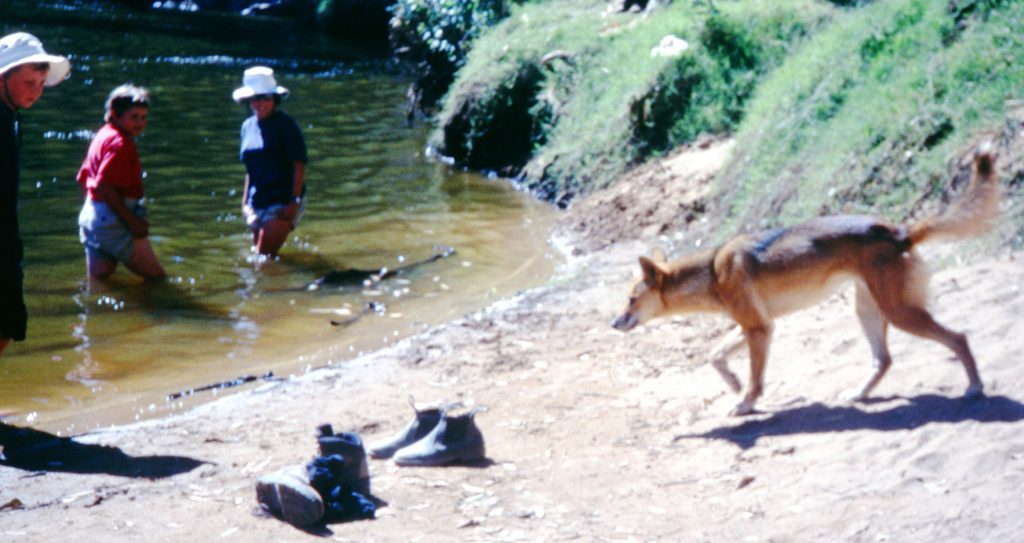
At some campsites, native animals have become unafraid of humans due to being fed by campers. This can cause significant problems, especially with children. It is very traumatic for a small child when food they are eating is snatched by an aggressive kangaroo, possum or parrot. There is also a risk of injury.
Ensure children do not add to the problem by feeding animals. Pick up any food dropped by toddlers.
Campfires and stoves
Sitting around a campfire is fun, but there are hazards associated with a campfire. It is important to establish some rules and stick to them. For example; Who is allowed to put wood on the fire? Can rubbish, leaves or bark be thrown on the fire? Are ‘fire sticks’ allowed?
A camping stove will be new to a child. They need to learn to keep well away when cooking is underway and the stove is in use.
Longer walks and overnight camping with teenagers

Teenagers can be introduced to the joys of longer walks including camping overnight, as they can carry a heavier pack. The full range of bushwalking skills can be learnt, including map reading and navigation, pitching a tent and cooking. The close supervision required for young children is no longer necessary, provided the young people have been well instructed on the hazards of their surroundings, and how to avoid them.
What can be carried?
A useful rule of thumb is that a child or teenager can carry a pack no heavier than 10% of their body weight. For a typical 14yo, the maximum pack weight will be around 5kg.
At best this weight could include a light sleeping bag, sleeping mat, rain jacket, spare clothes, water bottle, snacks and a torch.
Parents walking with younger teenagers need to be able to carry a substantial load, as the young person cannot carry their full share. From the above example, it leaves the parents to carry the full weight of tents, stove, food, emergency equipment including first aid kit, etc..
Planning the walk
For trips with younger and less experienced teenagers, and given the limitation on what both the teenager and parents can carry, the trip should:
- have at least two adults in the group.
- be in an area with good mobile phone reception.
- be in the milder months of the year. Less warm clothing and lighter sleeping bags will suffice.
- have the campsite reached after a few kilometers of relatively flat walking.
- have reliable drinking water available at the campsite.
Consider a National Park where a campsite booking is required. These campsites usually have good water and toilets, and a booking avoids the risk of finding the campsite is full. The alternative is walking to an area where good campsites abound.
Food: test run the proposed menu at home, so a spicy freeze dried or strange biscuits aren’t an issue on the trip. As with younger children, some surprise treats are good value, e.g. freeze dried ice cream.
On the track with teenagers
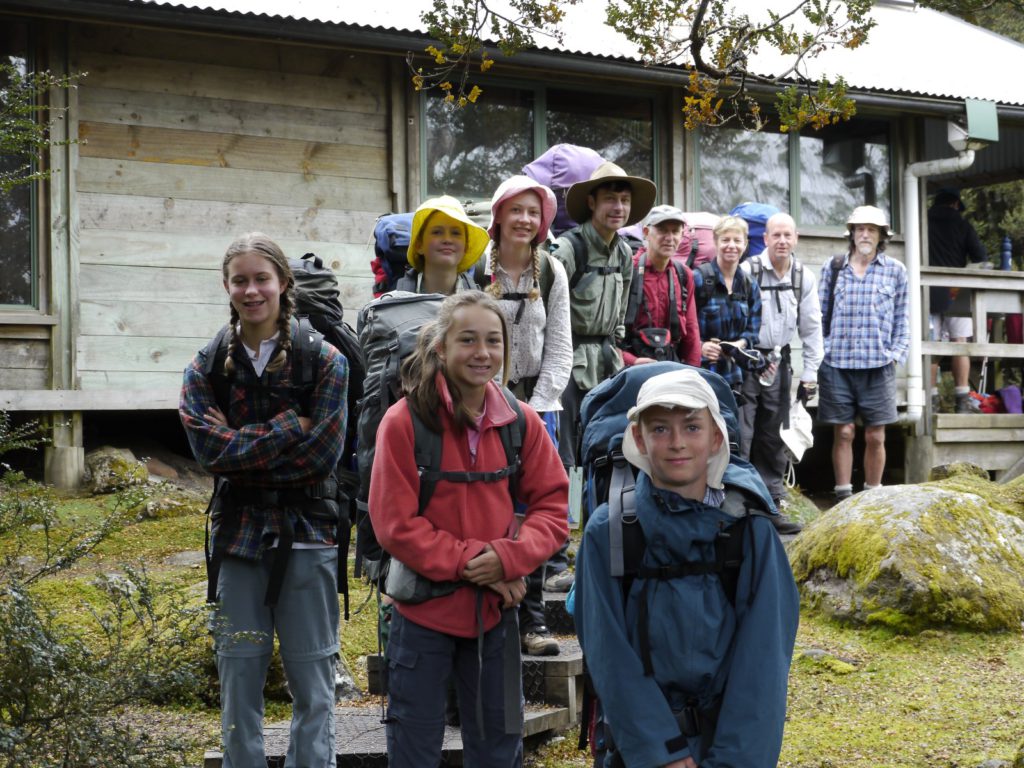
The normal protocols for a well organised bushwalking group are particularly important:
- The group keeps together, with a designated adult ‘whip’ bringing up the rear.
- The group walks at the pace of the slowest member.
- Rotate young people through the group, so the same individuals aren’t always down the back.
- Monitor the weather, and weather forecast. Be prepared to change plans if necessary.
Rest stops should be at regular intervals. Use the rest stop to:
- Check clothing is adjusted to suit conditions.
- Ensure adequate water is drunk. Prompt to refill waterbottles whenever drinking water is available.
- Check ‘nibbles’ are being nibbled.
- Attend to and treat any sore or rubbed spots on the feet or from pack straps.
- Prompt to reapply sunscreen.
- Discuss the route ahead, with reference to the map and track notes.
- Consult the field guide if any unusual plants or animals have been spotted.
On any walk with children and teenagers, it is essential to avoid overdoing it and pushing too hard. Striking the right balance is a challenge.
The walk has to be fun, but some minor misadventures will inevitably occur and help to foster a sense of achievement, develop resilience, and to learn some lessons.
References and external links
- Ramblers UK: Families with young children – United Kingdom
- Hill walking for families – Scotland
- Hiking With Young Kids: 16 Essential Tips – Ireland

